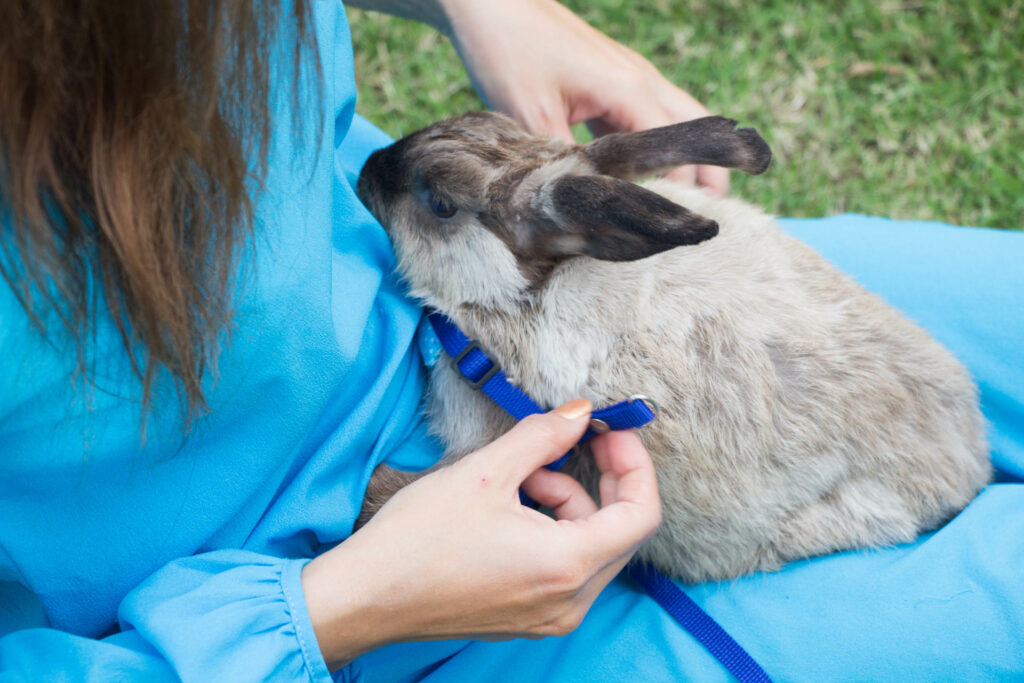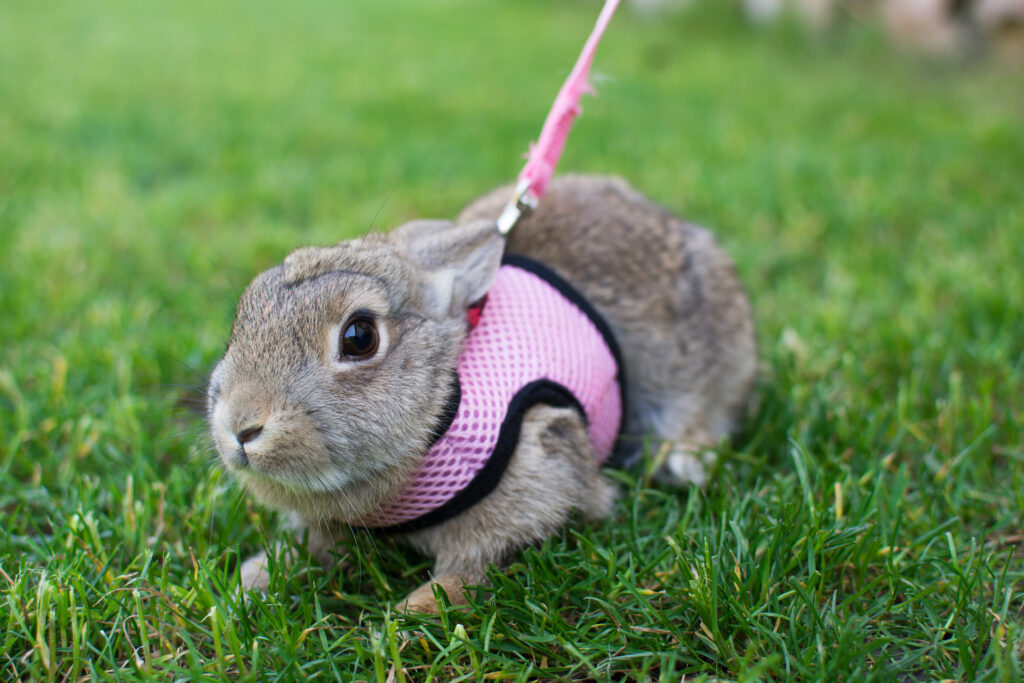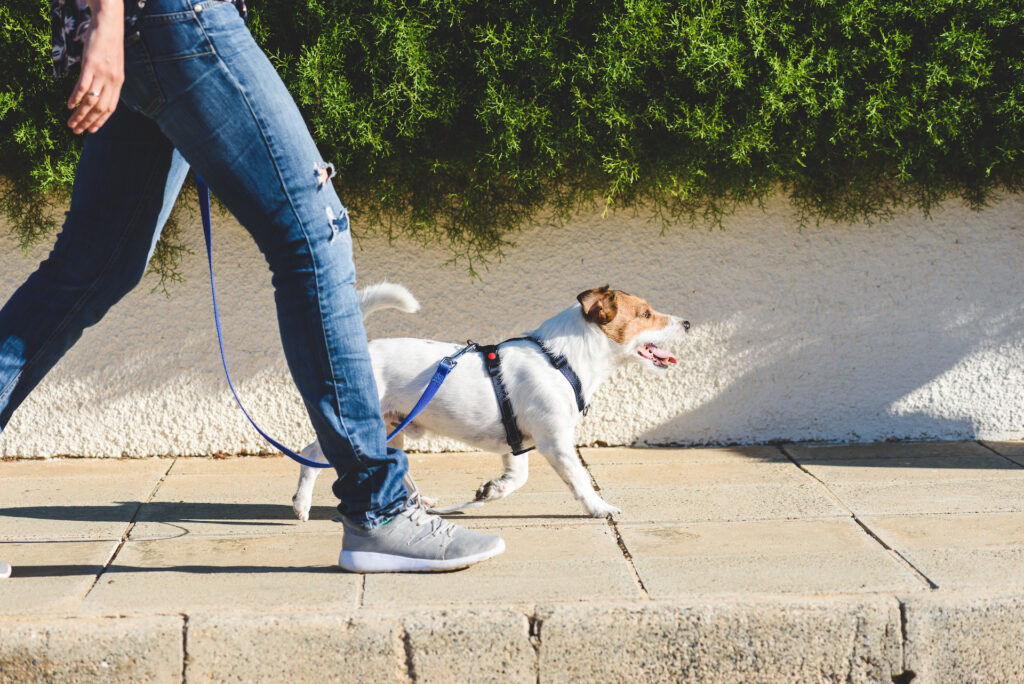Yes, you can take rabbits on walks. You can do this by putting a harness on your rabbit, attaching it to a leash, and then taking them for some exercise.
Make sure that you prioritize the safety of your rabbit at all times when walking them. You should try to find a quiet, grassy area where they can walk with as little stress as possible. You also need to make sure they are secure in a harness – if they escape it could be almost impossible to get them back.
Read on to find out everything you need to know about taking rabbits on walks.
How to Walk a Rabbit

Now you know that you can take your rabbit on walks, it’s important to learn exactly how to walk your rabbit.
Get a Harness

Pick up a harness from the pet store – the best and safest ones go around their waist and neck. You should then attach the leash to the waist loop so if they pull then the pressure is spread out across their belly and not just on their neck.
You’ll need to avoid anything that goes around your rabbit’s neck like a collar as they can easily cinch around their neck and cause an injury. Look out for ‘H-style’ harnesses that look like the letter ‘H’ when laid flat on the ground, they’re one of the easiest harnesses to adjust to your rabbit’s size as both sections can be tightened or loosened to fit.
How to Put a Harness on Your Rabbit

Keeping a firm hold on your rabbit, you should ease the harness over them, adjusting the straps so it’s loose enough to not be painful – but tight enough that they can’t escape. A general rule of thumb is to check if you can fit two of your fingers under the harness. If so, then you know that it’s a good fit.
During this time you should speak to them gently to keep them calm. You could also give them treats to associate putting a harness on with something positive.
Starting Small

Once your rabbit has the harness on, give them some time to adjust to the feeling of wearing a harness. You could put it on and let them wear it around your home for a small-time every day to get them used to it.
When they’re ready, attach the leash and try walking around your yard with it on. You should do this every day for a week before you venture anywhere else with them. Going slowly is key here.
Training Your Rabbit to Walk on a Leash

When walking your rabbit, it’s more accurate to say that they’re walking you. Your main role here is to keep hold of the leash and guide them away from danger. Be prepared to pick them up and carry them if needed.
Use treats as an incentive to walk, this would help particularly with aggressive or willful rabbits that don’t walk smoothly.
Stick to 10-20 minute walks at a time once or twice per day. You should let them hop along at their own pace and follow their cues. If they pause and rest, be patient with them. If you need them to move urgently, either coax them with treats or gently pick them up.
Extra Safety Tips

When walking your rabbit, look out for:
- Predators (birds, raccoons, or foxes).
- Other animals (dogs or cats).
- Dangerous objects on the ground (glass or sharps).
- Traffic (vehicles, bicycles, and other pedestrians).
- The temperature (is the sidewalk too hot? Your rabbit could get heatstroke).
- Bites and bugs (especially in the summer, check your rabbit for fleas, ticks, and bites).
- Watch out for anything they could eat that isn’t good for them.
Be prepared to pick up your rabbit and carry them if needed. Always make sure that the harness and leash are properly attached and that you have full control of your rabbit.
Benefits of Walking Your Rabbit

Walking your rabbit has some benefits that make a trip around the block worthwhile.
From walking, your rabbit gets:
- A change of scenery: This will go a long way towards preventing boredom and mentally stimulating your rabbit.
- Exercise: Rabbits are built for running through fields and need plenty of space to stretch their legs. If you don’t have much space for them to run at home, taking them out is a great idea.
- Gets them comfortable on a leash: This can be beneficial for a bunch of reasons, it could make visiting the vet easier, teach your rabbit discipline, and help make traveling smoother.
- Develop a routine: Having a routine will help your rabbit be more confident in their everyday life. They’re creatures of habit and will like following a routine and knowing what to expect next.
Drawbacks of Walking Your Rabbit

There are some cons that come with walking your rabbit that you might want to consider before getting a harness and leash.
- Poisoned: Rabbits eat all day long, and they don’t necessarily know if a food is good for them and could easily eat something that makes them sick. Watch out especially for grass or plants that have been treated with chemicals, as well as gum and cigarette butts.
- Scared: There are many aspects of being outside that could overwhelm or stress your rabbit out. There are loud noises, vehicles, and other animals to name a few.
- Risk of getting lost: There’s a small risk that your rabbit could get loose and run away in a panic. In the open world, there are millions of hiding places and a scared rabbit will run fast – so you might struggle to find them.
- Injury: Your rabbit could potentially get hurt when walking on the streets. They could cut their paws on glass or sharp objects, get into a fight with another animal, or in any number of ways for a small rabbit to get hurt.
- Disease: If your rabbit isn’t up to date on vaccinations and crosses paths with wild rabbits, there’s a chance that they could catch a disease.
- Weather dependent: Some days won’t be appropriate for your rabbit to be walked. This includes hot weather, extremely cold, and storms. Depending on where you live, there might not be many opportunities to take your rabbit for a walk.
Alternatives to Walking Your Rabbit

You might want the benefits of walking your rabbit but you can’t walk them on a leash. If so, you’re in luck – you’ve got some other options.
You could try:
- Playpens in the garden: Setting up a fenced-off area in your yard can give your rabbit the space to run about while in the safety of your own home. There are many options for the walls of the pen, and you can choose custom sizes and shapes to fit the space you have.
- Rabbit stroller: You can buy a stroller that has been specifically designed for rabbits to be securely held in. This gives them some fresh air, isn’t so heavy for you to carry, and is easier to maneuver on the streets.
- Rabbit carriers: There’s a wide range of carriers you can get for your rabbit. The best is undoubtedly a solid plastic box with ventilation and a handle. You’ll often see pets getting taken to the vets in these. As long as it is rabbit-proof and secure, it should work.
Related Questions
Can Rabbits Wear a Collar?
It’s possible to get a collar for your rabbit, but it’s not advisable to use them. They can get caught on a lot of items (bottles, hay racks, toys for example) and they’re also not great to be pulling on your pet’s neck.
If you do want to use a collar, try to get one with a quick-release clasp so you can undo it if it’s causing a problem. Also, stay close to your rabbit while they have the collar on, and above all else, you should never pull the leash and therefore tug on the collar.
Why Doesn’t My Rabbit Like Walking?
Your rabbit might not like walking for a number of reasons – but it could simply be that they don’t like the harness or the walk itself. At the end of the day, not every rabbit will want to go for a walk, while for some it’ll be their favorite pastime. You should follow their lead on how they feel about walking and try not to force them if they don’t want to walk.
